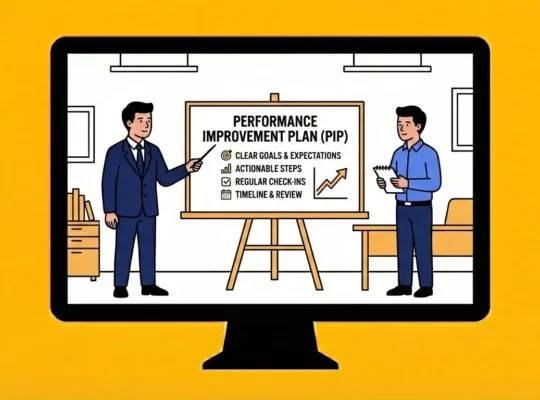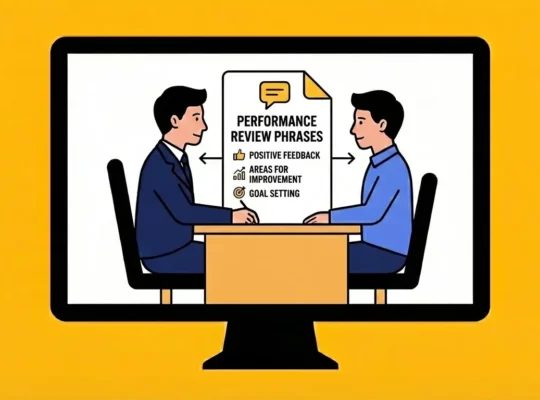Employee disengagement is a silent killer in the workplace. Unlike absenteeism or performance issues, disengagement can be subtle and insidious, eroding productivity, morale, and ultimately, organizational success. At Review.jobs, we understand the importance of fostering a thriving work environment. Recognizing and addressing the stages of employee disengagement empowers HR professionals, company leaders, and team managers to create a culture of engagement where employees feel valued, motivated, and connected to their work.
- What is Employee Disengagement?
- Disengagement vs. Burnout
- Causes of Employee Disengagement
- The Stages of Employee Disengagement
- Recognizing the Signs of Disengagement
- The Impact of Employee Disengagement on Organizations
- Strategies to Re-Engage Disengaged Employees
I. What is Employee Disengagement?
Employee disengagement refers to the emotional detachment an employee feels toward their work and the organization. This detachment manifests in various ways, ranging from a lack of enthusiasm and initiative to active negativity and even sabotage. Here’s a breakdown of the spectrum of employee engagement:
- Engaged Employees: These individuals are passionate about their work, consistently exceeding expectations, and demonstrably invested in the company’s success. They are vocal advocates for the organization and readily contribute their best efforts.
- Not Engaged Employees: These employees fulfill their basic job requirements but lack the emotional connection to their work. They are unlikely to go above and beyond or display high levels of initiative.
- Actively Disengaged Employees: These individuals are not only disengaged but also actively detrimental to the work environment. They may spread negativity, undermine company culture, and even engage in actions that harm productivity.
II. Disengagement vs. Burnout
| Aspect | Disengagement | Burnout |
| Definition | Lack of emotional connection or involvement in one’s work. | A state of physical, emotional, and mental exhaustion caused by prolonged or excessive stress. |
| Characteristics | Apathy, indifference, or detachment from the organization. | Feelings of overwhelming fatigue, cynicism, and reduced performance. |
| Motivation | Lack of motivation or enthusiasm to perform tasks. | Initially motivated but becomes depleted over time. |
| Capacity | Employees have the capacity to perform their jobs but choose not to. | Employees may lack the energy or mental resources to perform effectively. |
| Recovery Approach | This may improve with the active implementation of engagement strategies. | Often requires a comprehensive approach, including rest, stress management, and potential workload changes. |
| Symptoms | Emotional detachment from work, lack of engagement. | Physical symptoms such as headaches, insomnia, and digestive issues. |
III. Causes of Employee Disengagement
Disengagement can stem from a multitude of factors, creating a ripple effect that impacts both employee well-being and organizational performance. Let’s delve into some of the most common causes:
Lack of Recognition and Appreciation
Humans are social creatures who thrive on acknowledgment. When their contributions go unnoticed or unappreciated, employees may feel undervalued and demotivated.
Limited Career Growth and Development Opportunities
Stagnation is a major disengagement driver. When employees see no clear path for advancement or skill development, they may lose interest and seek opportunities elsewhere.
Poor Leadership and Management Practices
Ineffective leadership can poison the well of employee engagement. Micromanagement, unclear expectations, and a lack of support create frustration and confusion, ultimately leading to disengagement.
Inadequate Communication and Role Clarity
Clear communication and well-defined roles are essential for employee satisfaction. Without them, employees may feel lost, unsupported, and unsure of their contribution to the bigger picture.
Unfair Compensation and Benefits
Feeling undervalued financially can significantly impact employee engagement. When employees perceive inconsistencies in pay or believe their benefits package doesn’t reflect their worth, resentment and disengagement can take root.
Work-Life Imbalance and Burnout
Businesses that prioritize productivity above all else can inadvertently push employees toward burnout. Excessive workloads, long hours, and a lack of work-life balance lead to exhaustion, cynicism, and ultimately, disengagement.
IV. The Stages of Employee Disengagement
The journey towards complete disengagement often unfolds in distinct stages. Understanding these stages allows for early intervention and corrective action. Here’s a breakdown of the typical progression:
Stage 1: Discontent
The first stage is characterized by subtle signs of dissatisfaction. Employees may express minor complaints or exhibit a noticeable lack of enthusiasm. This stage is often triggered by unmet expectations, unaddressed grievances, or a general sense of being undervalued.
Stage 2: Decreased Productivity
As disengagement progresses, it starts to manifest in work output. Employees begin to show a decline in the quantity or quality of their work. This may be due to a lack of motivation, a growing sense of disillusionment with their role, or simply not caring enough to put in their best effort.
Stage 3: Lack of Participation
Disengaged employees may start withdrawing from team activities and collaborative efforts. They may miss meetings, avoid social interactions, and generally become less engaged with colleagues and team dynamics, resulting in weak employee connections. This is a sign they feel increasingly isolated and disconnected from the team.
Stage 4: Absenteeism and Increased Mistakes
Frequent absenteeism, lateness, and a rise in errors indicate deepening disengagement. Employees may be struggling with burnout, stress, or a sense of apathy that manifests in neglecting their responsibilities.
Stage 5: Complete Disengagement
At this critical stage, employees become entirely detached from the organization. They may be mentally checked out, putting in minimal effort, or even actively sabotaging company goals. This stage often leads to high turnover rates, as employees seek a more fulfilling work environment.
V. Recognizing the Signs of Disengagement
Early detection of disengagement is crucial for mitigating its negative impact. Here are some key indicators to watch for:
Behavioral Changes
- Decreased Productivity: A noticeable decline in output or quality of work can signal a loss of motivation or engagement. This might manifest as missed deadlines, increased errors, or a drop in overall performance.
- Reduced Initiative: Disengaged employees often demonstrate a lack of proactivity. They may avoid taking on new responsibilities, hesitate to offer suggestions, or appear less interested in contributing to team projects.
- Isolation: Withdrawal from team activities and social interactions is a common sign of disengagement. Employees may become increasingly solitary, spending more time alone and avoiding collaborative efforts.
Attitude Shifts
- Negative Outlook: A shift in attitude, characterized by increased complaining, pessimism, or cynicism, can indicate a growing disconnection from the organization.
- Decreased Enthusiasm: A loss of interest or passion for work is often a precursor to disengagement. Employees may appear less excited about projects or challenges.
- Apathy: A general lack of care or concern about work-related matters can be a significant red flag. This might manifest as a dismissive attitude or a lack of effort.
Communication Changes
- Reduced Communication: A decline in communication frequency or quality can signal a breakdown in engagement. Employees may become less responsive to emails, avoid team meetings, or provide minimal input during discussions.
- Defensive Behavior: Disengaged employees may become defensive or resistant to feedback or constructive criticism. This can hinder collaboration and teamwork.
- Lack of Collaboration: A decrease in willingness to share knowledge or collaborate on projects can indicate a growing sense of isolation and disengagement.
Attendance and Punctuality Issues
- Increased Absenteeism: Frequent sick days or other absences without legitimate reasons can be a sign of underlying issues, including disengagement.
- Tardiness: Consistent late arrivals or early departures may indicate a lack of commitment or motivation.
VI. The Impact of Employee Disengagement on Organizations
The consequences of disengagement extend far beyond individual employees, affecting the entire organization.
Decreased Productivity
Disengaged employees are less likely to be fully invested in their work. This manifests in lower output, missed deadlines, and reduced efficiency. Additionally, a negative work environment fostered by disengagement can spread, creating a ripple effect that impacts overall team productivity.
Negative Workplace Culture
Disengaged employees often contribute to a toxic work environment. Their negative attitudes can spread to colleagues, leading to decreased morale, increased conflict, and a decline in overall job satisfaction. A negative workplace culture can also hinder collaboration, innovation, and creativity.
Increased Turnover
Disengaged employees are more likely to seek employment elsewhere. The costs associated with turnover, including recruitment, onboarding, and lost productivity, can be substantial. Moreover, the departure of valuable employees can weaken the organization’s talent pool and negatively impact knowledge transfer.
Damaged Employer Brand
Employee disengagement can harm an organization’s reputation as an employer of choice. Negative reviews and social media posts from disengaged employees can deter potential candidates and damage the company’s brand image.
Financial Implications
The combined effects of decreased productivity, increased turnover, and reputational damage translate into significant financial losses. Reduced revenue, increased costs, and missed opportunities are common consequences of a disengaged workforce.
VII. Strategies to Re-Engage Disengaged Employees
Re-engaging disengaged employees requires a multifaceted approach that addresses the root causes of their dissatisfaction. Here are some effective strategies:
Open and Honest Communication
- Active Listening: Create a safe space for employees to share their concerns and frustrations without fear of judgment.
- Empathy and Understanding: Demonstrate empathy and validate employees’ feelings to build trust.
- Two-Way Conversations: Encourage open dialogue and seek feedback on how to improve the work environment.
Recognition and Appreciation
- Personalized Recognition: Acknowledge employees’ contributions and achievements publicly and privately.
- Reward Systems: Implement a robust recognition program that rewards exceptional performance and behaviors.
- Employee Appreciation Initiatives: Organize events or activities to show appreciation for employees’ hard work.
Career Development and Growth Opportunities
- Career Pathing: Develop clear career paths and growth opportunities for employees.
- Skill Development: Provide opportunities for training and skill enhancement.
- Mentorship Programs: Pair disengaged employees with mentors to offer guidance and support.
Work-Life Balance Initiatives
- Flexible Work Arrangements: Offer flexible work options like remote work or flexible hours to improve work-life balance. However, take measures to keep your remote employees engaged!
- Wellness Programs: Promote employee well-being through wellness initiatives such as fitness programs, stress management workshops, and mental health resources.
- Time Management Training: Equip employees with tools and techniques to manage their workload effectively.
Addressing Compensation and Benefits
- Compensation Review: Conduct regular salary reviews to ensure fair compensation.
- Benefits Assessment: Evaluate the benefits package to ensure it meets the needs of employees.
- Employee Surveys: Gather feedback on compensation and benefits to identify areas for improvement.
Strengthening Leadership
- Leadership Training: Set development goals for managers to equip them with the necessary skills to address disengagement and build strong relationships with employees.
- Performance Management: Implement effective performance management systems to provide regular feedback and coaching. Ask your employees the right performance review questions to measure their motivation and detect their setbacks.
- Employee Surveys: Conduct regular employee surveys to gauge morale and identify areas for improvement.
Leveraging Technology for Improved Communication
- Employee Feedback Platforms: Implementing platforms like Review.jobs allows employees to share their thoughts and concerns anonymously, fostering open communication.
- Collaboration Tools: Utilizing tools like Slack, Microsoft Teams, or Google Workspace enhances teamwork and facilitates knowledge sharing.
- Employee Recognition Platforms: Recognizing and appreciating employees through technology-driven platforms can boost morale and engagement.
Personalized Employee Experiences
- AI-Powered Recommendations: Using data analytics, organizations can offer personalized learning paths, career development opportunities, and job recommendations.
- Employee Assistance Programs (EAPs): Providing access to mental health resources and wellness programs through digital platforms can support employee well-being.
- Flexible Work Arrangements: Technology enables remote work, flexible schedules, and location-independent collaboration, promoting work-life balance.
Data-Driven Insights
- Employee Surveys: Conducting regular employee surveys and analyzing the data can identify areas for improvement and inform targeted engagement initiatives.
- Performance Analytics: Using data analytics to monitor employee performance and identify trends can help identify potential disengagement issues early on.
- Predictive Analytics: Leveraging data to predict employee attrition can help organizations take proactive steps to retain talent.
Understanding the stages of employee disengagement and implementing strategies to address them is vital for maintaining a positive and productive work environment. At Review.jobs, we encourage organizations to actively engage with their employees, recognize their contributions, and provide opportunities for growth and development. By doing so, businesses can foster a more engaged and productive workforce, ultimately leading to better outcomes for everyone involved.





